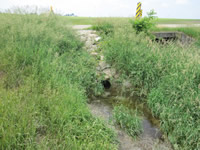Sediment and Nutrient Transport in Streams in an Agricultural Landscape
Research Info
Students: Luke Lampo, Ben Bruening, and Joe Miller
Advisors: Catherine O'Reilly, Eric Peterson
Collaboration with Shalamar Armstrong, Purdue University and Rick Twait, City of Bloomington
Nutrient losses from agricultural systems throughout the Midwestern USA have large negative impacts downstream. Nitrogen input from the Mississippi River watershed to the Gulf of Mexico leads to dead zones, which have widespread environmental and economic consequences. Locally, nitrate runoff leads to impaired water quality, often exceeding EPA drinking water limits. Many existing best management practices have yet to produce significant improvements in water quality in the central Midwest because most nutrients are lost through subsurface tile drain systems. Cover crops, planted and growing during the off-season, provide a potential mechanism for nutrient storage, and may reduce nitrogen and sediment losses as well as improve soil organic matter. We are investigating how different fertilizer management strategies and different types of cover crops influence soil characteristics and tile water chemistry across a series of corn-soybean experimental plots. We are also conducting whole-watershed experiments to assess whether cover cropping has the potential to influence surface water quality.
In addition to this research we are involved in several other surface water projects in the watersheds for Lake Bloomington and Evergreen, which are the drinking water reservoirs for the City of Bloomington, IL. More information on this and other projects can be found on the Water Research page.


Recent sediment and nutrient transport publications include (*indicates graduate student):
- Maxwell, E. L.*, Peterson, E. W., and O’Reilly, C. M., 2017, Enhanced nitrate reduction within a constructed wetland system: nitrate removal within groundwater flow: Wetlands, doi:10.1007/s13157-017-0877-5.
- Ackerman, J.*, Peterson, E., Van der Hoven, S., Perry, W., 2015, Quantifying nutrient removal from groundwater seepage out of a constructed wetlands receiving treated wastewater effluent: Environmental Earth Science, v. 74, no. 2, p. 1633-1645, doi10.1007/s12665-015-4167-3.
- Peterson, E.W., and Benning, C.*, 2013, Factors influencing nitrate within a low-gradient agricultural stream: Environmental Earth Sciences, v. 68, no. 5, 1233-1245, DOI 10.1007/s12665-012-1821-x.
- Peterson, E.W., Sickbert, T.B.*, and Moore, S.L.**, 2008, High frequency stream bed mobility of a low-gradient agricultural stream with implications on the hyporheic zone: Hydrological Processes, v. 22, p. 4239-4248